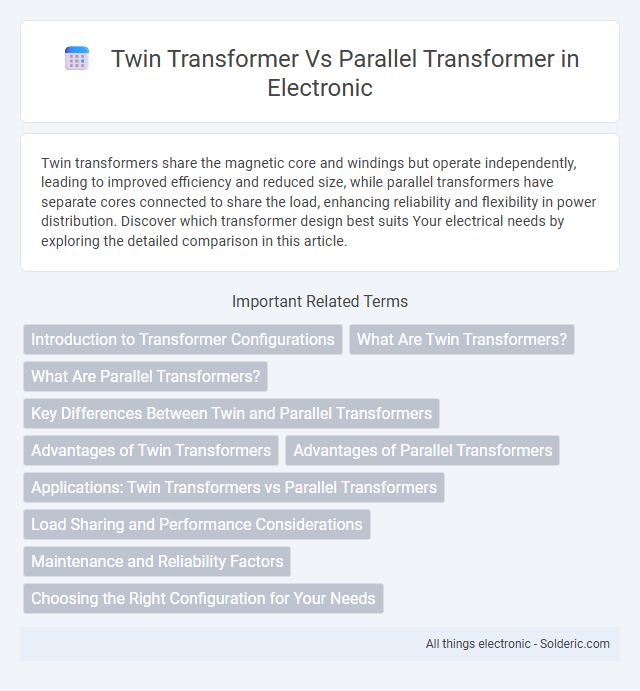Twin transformers share the magnetic core and windings but operate independently, leading to improved efficiency and reduced size, while parallel transformers have separate cores connected to share the load, enhancing reliability and flexibility in power distribution. Discover which transformer design best suits Your electrical needs by exploring the detailed comparison in this article.
Comparison Table
| Feature | Twin Transformer | Parallel Transformer |
|---|---|---|
| Definition | Two transformers connected in a specific arrangement for load sharing and redundancy. | Two or more identical transformers connected in parallel to increase capacity. |
| Connection Type | Series or special coupling for balanced operation. | Primary and secondary windings connected in parallel. |
| Load Sharing | Designed for equal load division with minimal circulating current. | Load shared based on rated capacity and impedance matching. |
| Capacity | Combined capacity but usually less than parallel transformers. | Capacity is sum of individual transformers' ratings. |
| Redundancy | High redundancy; one transformer can operate if the other fails. | Moderate redundancy; depends on load and fault conditions. |
| Complexity | More complex due to coupling and control requirements. | Simple connection; easier to implement. |
| Use Cases | Special applications needing precise load control and reliability. | Common in power distribution for scalability and maintenance ease. |
Introduction to Transformer Configurations
Transformer configurations such as twin transformers and parallel transformers are designed to optimize power distribution and system reliability. Twin transformers operate independently yet share the same load, enhancing redundancy and maintenance flexibility in electrical networks. Parallel transformers, connected to share a load simultaneously, improve capacity and efficiency by balancing the load between multiple units in power systems.
What Are Twin Transformers?
Twin transformers consist of two identical transformer units designed to operate in tandem, often sharing the electrical load for enhanced reliability and redundancy. They provide improved efficiency and fault tolerance in power distribution systems by ensuring continuous operation even if one unit fails. Commonly used in industrial and utility applications, twin transformers optimize space and maintenance costs compared to separate, standalone transformers.
What Are Parallel Transformers?
Parallel transformers are two or more transformers connected simultaneously to share the load and improve power capacity in electrical systems. They operate in synchrony, maintaining the same voltage and phase angle to distribute electrical load efficiently and enhance reliability. Proper matching of voltage ratings, impedance, and polarity is crucial to ensure effective parallel transformer operation without circulating currents or imbalances.
Key Differences Between Twin and Parallel Transformers
Twin transformers operate as two separate but identical units sharing load evenly, enhancing reliability by isolating faults, while parallel transformers connect directly to the same busbars, sharing load based on capacity and impedance for increased flexibility. Key differences include fault isolation, load sharing management, and operational redundancy, with twin transformers providing improved fault tolerance and parallel transformers offering scalable capacity. Twin transformers are ideal for critical systems requiring uninterrupted power, whereas parallel transformers suit applications needing adjustable load distribution and capacity expansion.
Advantages of Twin Transformers
Twin transformers offer enhanced reliability by distributing the load between two separate units, reducing the risk of complete power failure. They provide greater flexibility in maintenance schedules, allowing one transformer to be serviced without interrupting the entire system. Your electrical setup benefits from improved efficiency and scalability, making twin transformers ideal for systems requiring consistent power supply and adaptability.
Advantages of Parallel Transformers
Parallel transformers enhance power system reliability by sharing load currents, reducing the risk of failure from a single transformer outage. They offer increased flexibility for maintenance without disrupting your power supply, ensuring continuous operation in industrial or commercial settings. Load balancing and improved voltage regulation are significant benefits, optimizing energy efficiency and system performance.
Applications: Twin Transformers vs Parallel Transformers
Twin transformers are ideal for applications requiring redundancy and high reliability, such as critical industrial processes and power distribution systems, ensuring continuous power supply during maintenance or failure. Parallel transformers suit scenarios demanding increased capacity and load balancing in electrical grids, allowing multiple transformers to share load efficiently and enhance system flexibility. Your choice depends on whether reliability or capacity expansion is the primary objective for your electrical infrastructure.
Load Sharing and Performance Considerations
Twin transformers and parallel transformers both share electrical loads, but twin transformers typically operate independently with separate windings, which reduces the risk of circulating currents and improves fault tolerance. Parallel transformers require precise matching of voltage ratings and impedance to ensure balanced load sharing and maintain system stability. Your choice depends on performance needs, where twin transformers offer flexibility and reliability, while parallel transformers provide efficiency in handling higher loads.
Maintenance and Reliability Factors
Twin transformers offer enhanced reliability by allowing one unit to take over if the other fails, reducing downtime during maintenance. Parallel transformers share load evenly, but require precise synchronization and regular maintenance to prevent issues like circulating currents that can compromise reliability. Your maintenance strategy should consider accessibility and fault tolerance, with twin transformers providing easier isolation for servicing compared to parallel units.
Choosing the Right Configuration for Your Needs
Selecting between twin transformer and parallel transformer configurations depends on load requirements and system redundancy needs. Twin transformers offer independent operation and increased reliability, ideal for critical applications requiring continuity during maintenance. Parallel transformers share load to enhance capacity and efficiency, making them suitable for systems with fluctuating power demands.
twin transformer vs parallel transformer Infographic

 solderic.com
solderic.com